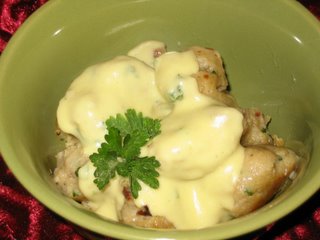
After picking up my cone of Schabziger cheese yesterday, I paid a visit to the maker's website and perused the recipes. The pale green cheese most often ends up grated into a sauce and poured over potatoes, fish, just about anything. So I got to thinking that potato gnocchi would probably taste good with some Schabziger tossed in. Then I got to reading a Julia Child book and thought that maybe a modified
sauce parisienne would be really good poured over the gnocchi. Finally the idea of adding onions and bacon to whole wheat dumplings really sounded good to me, so I ended up with the recipes below. If only I had a really cool Swiss name to attach to it. How about...
Herdöpfelknödeln mit Glarner Schabzigersosse
Dumplings:
2 pounds boiling potatoes
3 cups whole wheat flour
1 cup all purpose flour
1 medium onion, finely chopped
1/3 pound bacon
2 T finely chopped parsley
1 ounce grated Glarner Schabziger cheese
1/4 c grated parmesan cheese
1 egg, beaten
salt and pepper to taste
Boil or pressure-cook the potatoes until tender. While the potatoes cook, fry the bacon until very crisp, remove to paper towels, and break the strips up into little bits. Drain all but one tablespoon of the bacon fat from the skillet and fry the onions in it over medium heat until they are soft and golden. Peel and mash the potatoes and begin working in the flour until it is all incorporated and the dough is smooth. Add the parsley, Schabziger, parmesan, bacon and onion. Season if necessary with salt and pepper. Add the egg and mix thoroughly. Set a large pot of salted water to boil, and in the meantime, prepare the sauce below. Once the water is at a rolling boil, form teaspoon-sized dumplings and drop into the water. Cook until they float to the surface, about 5 minutes. Remove with a slotted spoon and set aside as you continue cooking the rest of the dough.
The dumplings taste fine boiled, but like most things, they taste better after being panfried in butter. Brown as many as you want in a hot skillet with butter, and top with the sauce. Freeze the rest if you like.
Sauce:
2 T butter
3 T flour
1 c chicken broth (bouillon is fine)
1/2 c milk
1/2 c white wine
1 T finely chopped parsley
1 ounce grated Schabziger
2 egg yolks
1/4 c cream or milk
salt and pepper to taste
In a saucepan over low heat, melt the butter and whisk in the flour. Cook for 5 minutes without coloring. Slowly add the broth, 1/2 c milk, and wine, whisking constantly to avoid lumping. Bring to a boil as you continue stirring. The sauce should be quite thick, but still manageable with the whisk. Mix in the cheese and parsley and remove from the heat. In a separate bowl or saucepan, beat the egg yolks with the remaining milk (or cream) until smooth. Whisk in the hot cream sauce by driblets at first to avoid cooking the yolk. After adding about 1/2 cup of the sauce, you can increase the addition to a steady stream. Return the sauce to the heat, bring to a boil while stirring, and cook for one minute. Adjust the seasoning and pour the custardy sauce over the dumplings.
Would I make them again? That depends. If I were running a bed and breakfast in Glarus, and I wanted to give the guests a taste of the local Schabziger, this would be an excellent introduction. These dumplings probably won't make it into my favorite meal rotation, but they are tasty and the sauce is excellent. You could go with just parmesan instead of the green wondercheese, or you can omit the cheese altogether and serve these dumplings with a roast and gravy on Sunday. Me, I'm going to enjoy my leftovers and experience that unique Schabziger taste a few more times.



